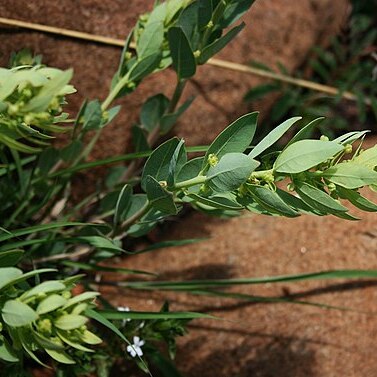Male flowers: pedicels up to 1.7 cm long, capillary; sepals 2.5 × 1.5 mm, elliptic-obovate, rounded, each with c. 5 clavate glands near the base, pale yellowish-green; petals 1.5 × 1 mm, triangular-rhombic to obovate-spathulate, each with c. 5 ± spherical glands at the base, whitish; staminal column c. 1 mm high, free filaments 0.67 mm long, anthers 0.67 mm long, white; pistillode c. 1 mm high, cylindric, slightly expanded apically.
Female flowers solitary; pedicels 1–1.3 cm long, extending to c. 2.5 cm in fruit; sepals c. 2 × 1 mm, elliptic-oblong, each with a small ± flattened 2-lobed basal gland, otherwise as in the male; petals 2 × 1 mm, rhombic-elliptic, eglandular, otherwise as in the male; ovary c. 1.5 mm in diameter, smooth, glabrous; styles c. 1 mm long, spreading.
Leaf blades 0.7–3 × 0.5–2 cm, suborbicular-ovate in lower leaves, elliptic-ovate in upper leaves, or all elliptic-oblong, rounded, obtuse or subacute at the apex, broadly cuneate or rounded at the base, membranous to firmly chartaceous, pellucid-punctate and pusticulate; margins entire, slightly revolute; lateral nerves in 3–5 pairs, looped.
Perennial herb, up to 350 mm tall, many-stemmed. Leaves cuneate or rounded at base, sessile, ovate-oblong to ovate-lanceolate, up to 40 mm long. Ovary glabrous. Flowers greenish white to yellow.
Seeds 2.5 × 2 × 1.5 mm, obovoid, minutely punctate; caruncle c. 1 × 1 mm, thin, papyraceous, straw-coloured.
Stems several simple or subsimple, up to c. 60 cm high, arising from a woody stock.
Male fascicles 1–5-flowered; bracts 0.5–1 mm, triangular, chaffy.
Fruit 4–4.5 × 4.5–5 mm, punctate, glabrous, ochreous.
Petioles 0.5–3 mm long, or leaves subsessile.
A glabrous perennial herb, dioecious.
Stipules absent.

